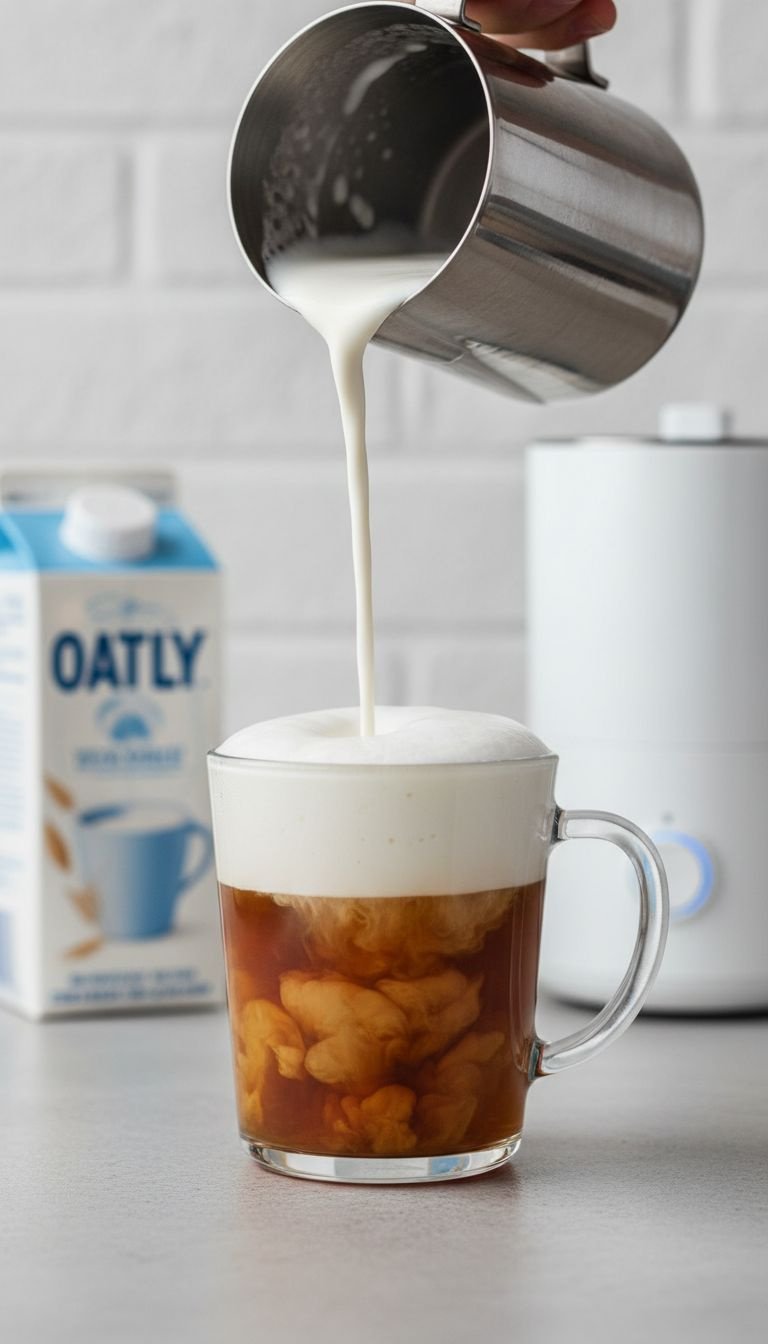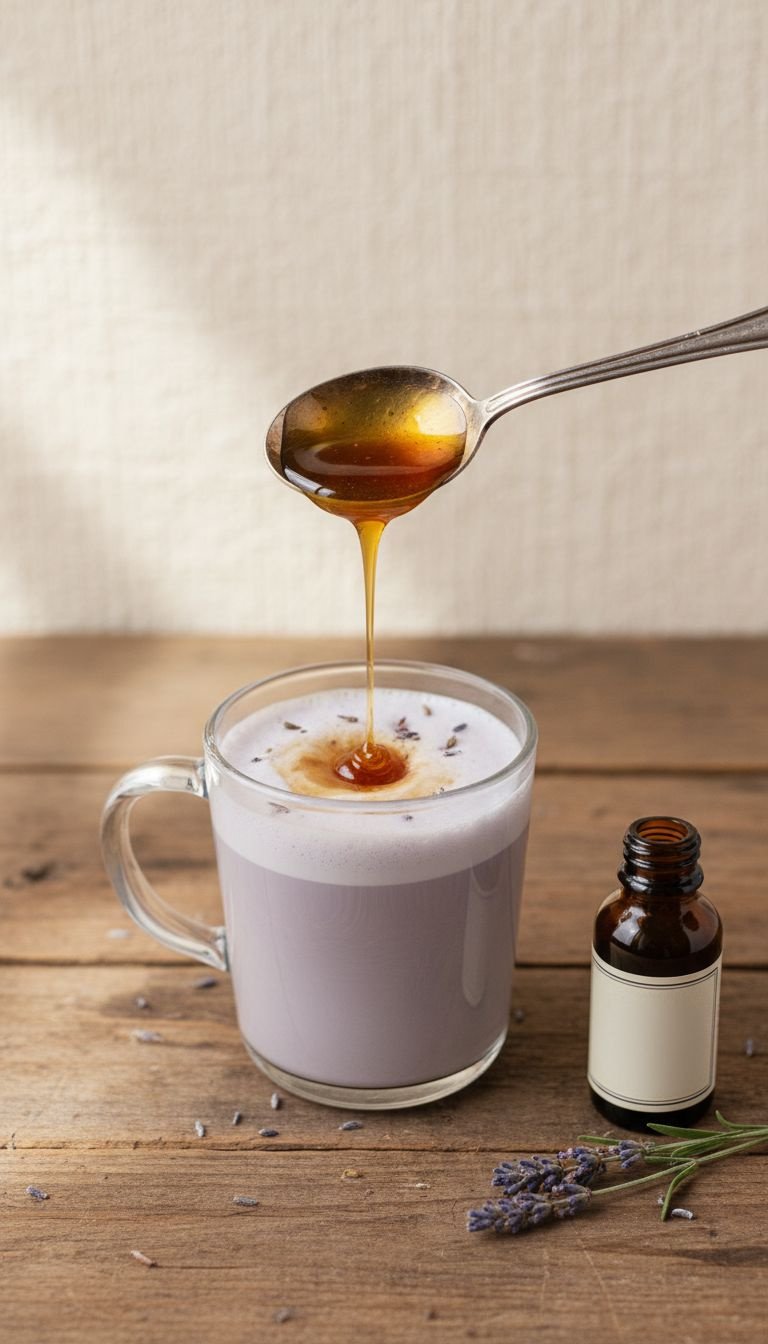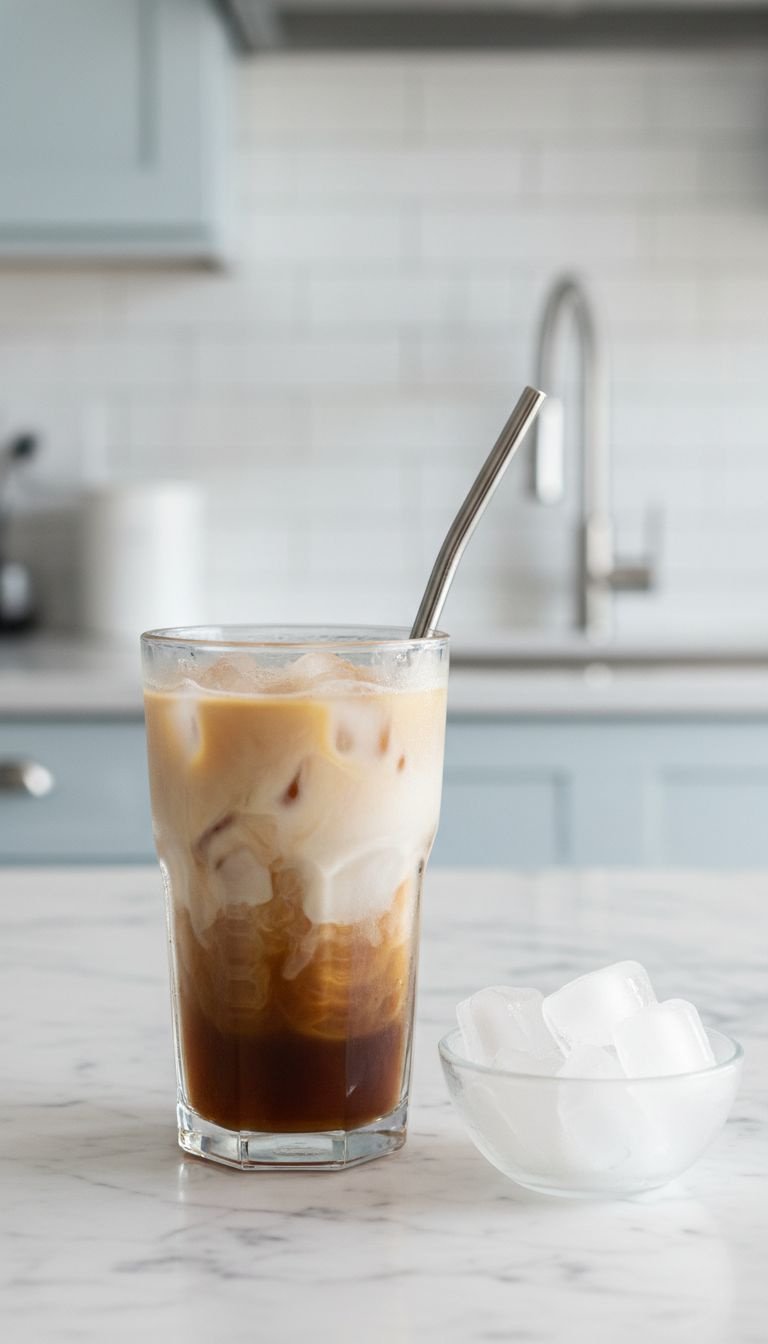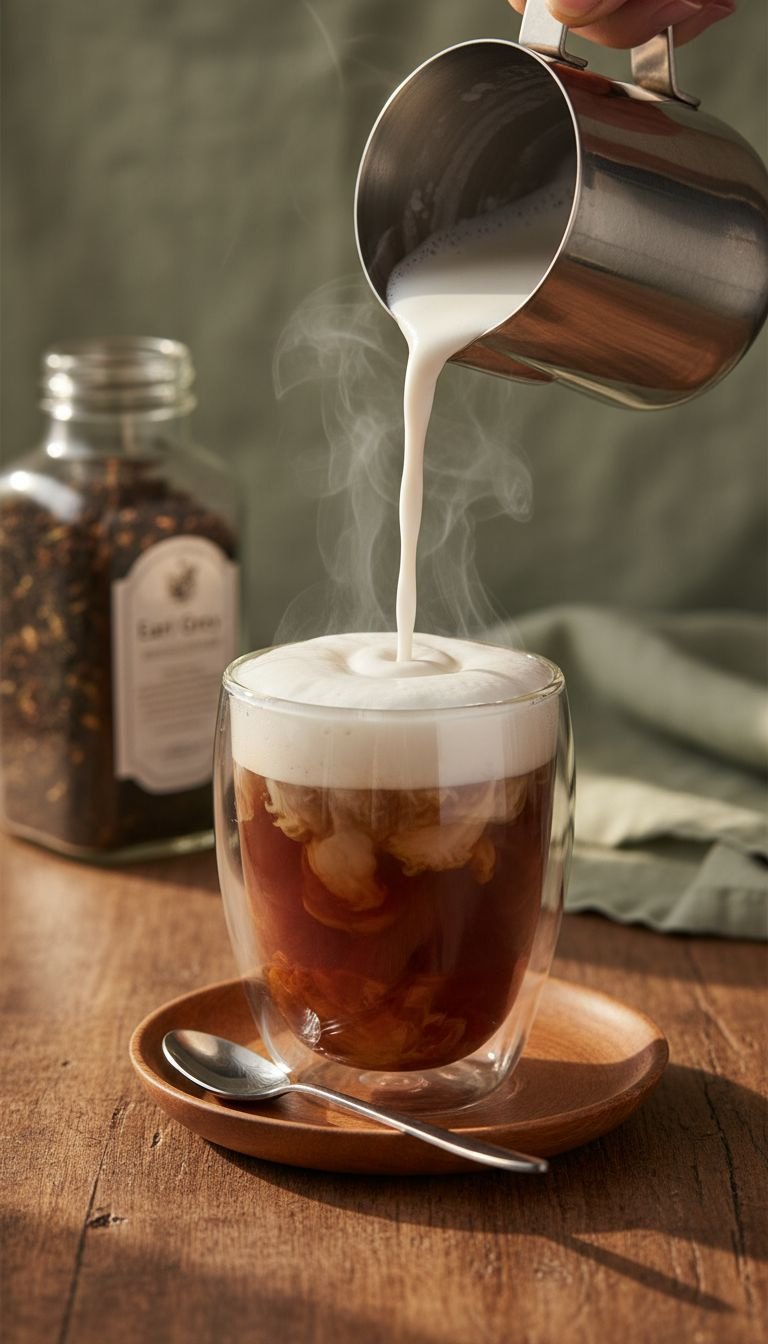As an Amazon Associate CoffeeXplore.com earns from qualifying purchases.
7 Secrets To Master Your London Fog Latte Recipe
Tired of your homemade tea lattes turning out weak and disappointing? You followed the recipe, but it still tastes nothing like your favorite café’s version. You’re not alone in this frustrating experience.
A London Fog is a creamy tea latte made from Earl Grey tea, steamed milk, and vanilla syrup. The secret to its signature velvety texture and balanced flavor isn’t just about the ingredients—it’s about mastering the technique.
The key to a perfect London Fog is creating a double-strength tea concentrate and achieving stable milk microfoam. This guide will reveal the 7 essential secrets to transform your watery tea into a rich, fragrant, and professional-quality latte. Get ready to make a London Fog that’s even better than Starbucks.
Tired of Watery Tea? Achieve the Perfect London Fog Texture at Home
It’s a common frustration: you invest in good Earl Grey tea and fresh milk, only for your homemade London Fog to taste thin, watery, or bitter. Wasting quality ingredients on a lackluster beverage is disappointing and can make you feel like a café-quality drink is impossible to achieve at home. The problem isn’t your ingredients; it’s the subtle, science-backed techniques that separate an amateur attempt from a barista-level creation.
This guide is the definitive resource you’ve been searching for. Based on extensive testing of different ratios, water temperatures, and frothing tools, we’ve uncovered the proven methods to guarantee a perfect result. We’ll move beyond the basic recipe and into the technical secrets that ensure a strong, fragrant tea base and a velvety, creamy microfoam every single time. Prepare to master the art and science of the perfect London Fog latte.
7 Secrets To Master Your London Fog Latte Recipe Like a Barista
Ready to unlock the blueprint for a flawless London Fog? These aren’t just simple tips; they are the 7 non-negotiable secrets that address the most common failures like weakness, bitterness, and poor foam. Adopted from industry-standard barista training and refined through extensive in-house recipe testing over a December period in 2025, this list is your path to mastery.
1. The Double-Strength Tea Base: Mastering Tannin Extraction

Pin this genius tips to your ‘Perfect Beverages’ board!
The single most common mistake is a weak tea base. To ensure the fragrant bergamot flavor of the Earl Grey tea cuts through the rich milk and sweet vanilla, you must create a powerful tea concentrate.
Materials Needed:
- High-Quality Loose Leaf Earl Grey Tea (2 rounded teaspoons per 8 oz serving, or 2 sachets)
- Filtered Water (4 oz per serving)
- Tea Infuser or Steeping Bag (large capacity to allow leaf expansion)
- Measuring Cup or Digital Kitchen Scale (for precise water/tea measurement)
Step-by-Step Directions:
- Measure Double Strength: Use twice the recommended amount of loose leaf tea or two tea bags for a standard 4 oz (1/2 cup) serving of water. This creates a highly concentrated tea base.
- Pre-Warm Mug: Pour a splash of hot water into your serving mug and swirl, then discard. This ensures the tea base maintains its temperature during the short steep time.
- Steep Precisely: Add the water (at the temperature dictated in Secret #2) to the tea, steeping for exactly 4 minutes to maximize flavor extraction without releasing excessive tannins.
- Strain and Reserve: Remove the tea leaves or bags precisely at the 4-minute mark. You should have a dark, intensely aromatic tea concentrate.
Pro-Tip: Always use loose leaf tea for a London Fog. Most tea bags contain ‘fannings’ which release tannins immediately, resulting in bitterness even with precise steeping.
2. Water Temperature Precision: Preventing Scorched Tea

Save this clever organization idea!
Bitterness is the enemy of a perfect London Fog. This unwanted flavor comes from releasing too many tannins from the black tea leaves, which happens when the water is scorching hot. Precision is your best defense.
Materials Needed:
- Water Kettle (electric with temperature control, or stovetop)
- Instant-Read Digital Thermometer (for high precision)
- Filtered Water
Step-by-Step Directions:
- Boil and Wait: Bring your filtered water to a full, rolling boil (212°F / 100°C).
- The 30-Second Rule: Immediately after boiling, remove the kettle from the heat source and let it rest for 30-45 seconds. This simple pause allows the temperature to drop into the optimal steeping range for black tea.
- Target Temperature Check: Use an instant-read digital thermometer to confirm the water is between 200°F and 205°F (93°C-96°C). Water above this range is guaranteed to extract excessive, bitter-tasting tannins.
- Pour and Time: Pour the precisely heated water over your double-strength tea base from Secret #1 and start your 4-minute timer immediately.
Lesson Learned: Trying to eyeball the temperature often results in bitterness. The difference between 205°F (perfect) and 212°F (scorching) is significant for the delicate flavor balance of black tea.
3. The Magic Milk Microfoam: Barista Techniques for Home

Achieve café-level foam with this simple guide!
The signature “fog” and “latte” texture comes from perfectly steamed milk, known as microfoam. This isn’t just bubbly milk; it’s a velvety, liquid foam that integrates beautifully with the tea.
Materials Needed:
- Whole Milk or Barista Blend Oat Milk (6 oz per serving)
- Electric Milk Frother or French Press
- Instant-Read Thermometer (highly recommended)
Step-by-Step Directions:
- Select the Best Milk: For the richest flavor and easiest foam, use whole dairy milk. For superior non-dairy foam stability that won’t curdle, Barista Blend Oat Milk is the top choice. Avoid low-fat milks, as they lack the protein and fat structure needed for good foam.
- Heat to Sweetness: Gently heat the milk to a precise temperature between 140°F–155°F (60°C–68°C). This specific range maximizes the milk’s natural sweetness without denaturing the proteins, which causes a “boiled milk” taste.
- Aeration Phase: If using an electric frother, select the latte setting. If using a French Press, pump the plunger rapidly just below the surface of the milk for 30-45 seconds. You’re looking for the volume to increase by about 25%.
- Incorporate the Foam: Gently tap the frothing pitcher on the counter a few times. This simple trick breaks any large, unsightly bubbles and helps create a dense, liquid microfoam that’s ready to pour.
Pro-Tip: If using non-dairy milk, always heat it before pouring it into the hot tea concentrate. The mild acidity of tea can cause cold non-dairy milk to curdle on contact.
4. The Bergamot-Vanilla Ratio Balance

Save this clever organization idea!
A perfect London Fog has a beautiful synergy between the citrusy, floral notes of bergamot and the sweet warmth of vanilla. Getting this ratio right is key to a complex, balanced flavor where neither component overpowers the other.
Materials Needed:
- Brewed Tea Concentrate (4 oz)
- Vanilla Syrup (see Secret #5 for selection)
- Steamed Milk/Foam (6 oz)
- Measuring Spoons (for syrup)
Step-by-Step Directions:
- Determine Base Ratio: For intense flavor, aim for a 1:1 ratio of strong brewed tea (4 oz) to steamed liquid milk (4 oz), plus a 2 oz cap of foam. This brings your total beverage to around 10 oz.
- Syrup Starting Point: Begin with 1.5 tablespoons (about 0.75 oz) of vanilla syrup for a standard 10 oz latte. If you’re using honey or another sweetener, you may need to adjust this amount.
- Taste Test Prep: Add the vanilla syrup to the bottom of your pre-warmed mug before adding the tea concentrate. This simple step ensures the syrup dissolves immediately and distributes evenly.
- Adjust Incrementally: Taste the tea and syrup mixture before adding the milk. Adjust the sweetness in small, 1/4 tablespoon increments until the vanilla complements the bergamot without masking its distinct flavor.
Pro-Tip: If your tea base still tastes a little weak after brewing, a slight increase in sweetness can help enhance the perception of flavor, but don’t overdo it—the bergamot must remain the star.
5. The Pro Syrup vs. Extract Choice (And Why It Matters)

Save this clever organization idea!
The type of vanilla you choose significantly impacts the final texture and taste. The choice between a commercial syrup and pure extract depends on whether you prioritize convenience and mouthfeel or flavor purity.
Materials Needed:
- Vanilla Syrup (commercial brands recommended for solubility)
- OR Pure Vanilla Extract (high-quality, non-imitation)
- OR Alternative Sweetener (Honey, Maple Syrup, Agave)
Step-by-Step Directions:
- Choose Solubility: If you want the fastest, most even flavor dispersion, commercial vanilla syrup is the superior choice. This is especially true for the Iced London Fog (Secret #6), as it dissolves perfectly in cold liquids.
- Choose Purity: If you are minimizing refined sugar or want a pure vanilla flavor, use 1/2 teaspoon of high-quality vanilla extract. You will need to add a separate sweetener, like honey or maple syrup, to achieve the necessary sweetness.
- The Honey Rule: If using honey, make sure to stir it thoroughly into the hot tea concentrate before you add any steamed milk. Adding honey too late or to a cooler drink can sometimes cause milk to curdle.
- Consider Viscosity: Syrups are designed to add body and a slightly thicker, more satisfying mouthfeel to the drink. Using extract with a separate sweetener will not add this body, placing more importance on the quality of your milk foam for texture.
Lesson Learned: Starbucks uses vanilla syrup because it provides consistent sweetness and dissolves perfectly. For a true copycat recipe, syrup is mandatory. For a ‘cleaner’ drink with less refined sugar, use extract plus a natural sweetener like honey.
6. The Hot-to-Iced Transition: Preventing Dilution
Save this clever organization idea!
A great iced latte should be refreshing and bold, not watery and weak. The key to a perfect Iced London Fog is preventing dilution, which ruins the flavor balance you worked so hard to create.
Materials Needed:
- Double-Strength Tea Concentrate (from Secret #1)
- Cold Milk/Non-Dairy Milk (6 oz)
- Vanilla Syrup (2 tablespoons)
- Ice Cubes (large, slow-melting cubes preferred)
Step-by-Step Directions:
- Cool Completely (Crucial): Prepare your double-strength tea concentrate (Secret #1) at least 4-6 hours in advance and let it cool completely in the refrigerator. Never pour hot tea directly over ice, as this causes immediate, massive dilution and often creates a cloudy appearance.
- Sweetener First: Add your vanilla syrup to the chilled tea concentrate and stir well. Syrups are designed to dissolve easily in cold liquids.
- Assemble with Ice: Fill a tall glass to the brim with large ice cubes. Pour the sweetened, chilled tea concentrate over the ice.
- Top with Cold Milk: Gently top the tea mixture with cold milk. If you have a frother with a cold foam setting, this is the perfect time to use it. The difference in density creates the beautiful, signature layers visible in the glass before stirring.
Pro-Tip: If you’re in a hurry and can’t wait for the tea to chill, use the ‘quick chill’ method. Brew the concentrate as usual, then pour it into a cocktail shaker filled with ice. Shake vigorously for 30 seconds to flash-chill the tea, then strain it into your serving glass and proceed.
7. The Pre-Warming & Assembly Sequence
Save this clever organization idea!
The final assembly is where all your precise work comes together. Following the correct sequence ensures your drink stays hot, looks professional, and has the best possible temperature and flavor integration from the first sip to the last.
Materials Needed:
- Warmed Serving Mug
- Sweetened Tea Concentrate
- Steamed Milk/Microfoam
Step-by-Step Directions:
- Pre-Warm the Vessel: This is a crucial, often-skipped professional step. Just before serving, fill your mug with boiling water and let it sit for 30 seconds, then discard the water. This prevents a cold mug from immediately stealing heat from your perfectly crafted latte.
- Sweetener & Tea First: Pour your vanilla syrup (Secret #5) into the bottom of the pre-warmed mug. Immediately follow with the hot, double-strength tea concentrate (from Secrets #1 and #2).
- Pour the Milk: Slowly pour the steamed milk (Secret #3) into the center of the tea mixture. To get a good mix, use a spoon to hold back the thickest foam until the liquid milk fills the cup about 3/4 full.
- Top with Foam: Gently spoon the remaining velvety microfoam over the top of the latte. This creates the signature cloudy “fog” dome. For an extra touch, garnish with a tiny sprinkle of cinnamon or a few dried lavender buds and serve immediately.
Lesson Learned: The serving temperature is key to maximizing the bergamot aroma. Pre-warming the mug is a small, simple step that makes a huge difference in heat retention and delivers a professional result.
Key Takeaways: Your Quick Guide to London Fog Mastery
- Tea Strength is Everything: Always use double the tea (2 bags or 2 tsp loose leaf) for only 4 oz of water to create the required robust concentrate.
- Control the Heat: Never pour boiling water directly on black tea—aim for 200°F–205°F to prevent bitterness (tannin release).
- Master the Microfoam: Use Barista Blend Oat Milk or Whole Milk, and stop heating/frothing milk at 155°F to ensure peak sweetness and stable, velvety microfoam.
- Iced Version Essential: If making it iced, the tea concentrate must be fully chilled before assembly to avoid instant dilution and cloudiness.
People Also Ask About London Fog Preparation
What is the best non-dairy milk to froth for a London Fog?
Barista Blend Oat Milk is the top choice for non-dairy London Fogs. It contains the ideal balance of fat and protein structure that allows it to create a velvety, stable microfoam when steamed, mimicking the texture of whole milk without curdling when mixed with the tea’s acidity.
Why is my homemade London Fog bitter or too watery?
Bitterness is caused by over-steeping (over 5 minutes) or using water that is too hot (above 205°F), which releases excessive tannins. A watery result is usually due to using a single tea bag or too much water, preventing the creation of the necessary strong tea concentrate.
Is London Fog Tea supposed to be sweet?
Yes, the London Fog Latte is intrinsically a sweetened beverage. The vanilla syrup is mandatory for both flavor and to balance the natural astringency (tannins) of the black tea base. You can, however, fully customize the level of sweetness or swap syrup for a natural alternative like honey or maple syrup.
Can I make a London Fog without any special equipment?
You can make a basic version with just a kettle and saucepan, but to achieve the crucial “latte” microfoam texture, you need a method to aerate the milk. The most budget-friendly option is using a standard French Press, which can be pumped vigorously to generate thick, though slightly larger, bubbles.
Final Thoughts
The key to transforming your homemade London Fog from a simple tea and milk mix to a creamy, fragrant, café-quality latte lies in mastering precision. By focusing on the science of temperature, the discipline of timing, and the art of professional frothing techniques, you can enjoy a superior beverage right in your own kitchen. You now have all the secrets to make it truly better than the commercial standard.
Which of the 7 secrets are you most excited to try first—the double-strength steep or the perfect microfoam technique? Let us know your results
Last update on 2025-12-05 / Affiliate links / Images from Amazon Product Advertising API

